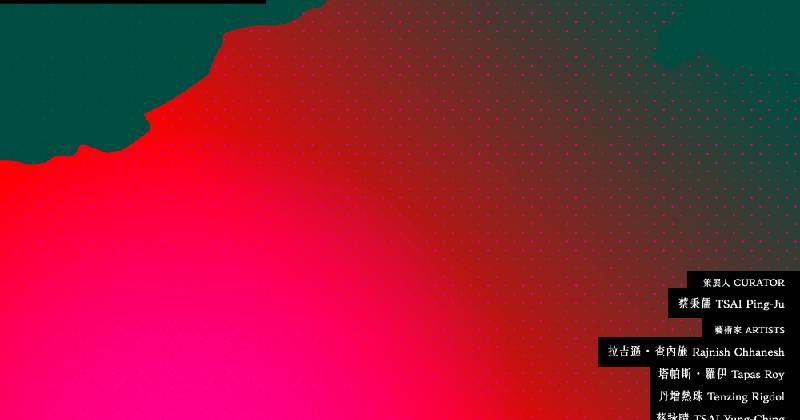福利社 FreeS Art Space
【方域之外】國際交流展

-
展期
日期:2020-10-17 ~ 2020-11-14
-
地點
福利社(104 台北市中山區新生北路三段82號B1)
-
參展藝術家
拉吉遜.查內施Rajnish Chhanesh、塔帕斯.羅伊Tapas Roy、丹增熱珠Tenzing Rigdol、蔡詠晴、李奎壁、尤芷薇+賴佩君
-
邊界界定了現代化主權國家權力所能及的範圍,在該範圍中,國家透過治理技術區分良劣,並且驅逐異己來維護自身的存續。而被排除於外的流亡者,便成了今日世界裡最能體現生命政治的一員。
在歐洲難民潮當中,這批跨越邊界的流亡人士雖然喪失了行使公權力的力量,卻透過其他方式撼動過去國與國之間的關係。從英國脫歐公投到唐納.川普當選美國總統,人們開始檢視自己分享權力的對象,透過民主機制與大眾傳媒,試圖再次找回舊時以血緣及地域為主的認同感。
展覽名稱「方域之外」意指作用在透過政治與經濟競合不斷變動的邊界上,以想像及衝撞所展開的測量術。方域即「地方」、「國內」,20世紀初曾作為中國政府處理邊界領土糾紛的部門名稱,而延續帝國主義的擴張與殖民勢力的影響,英國探險家麥克馬洪在測量西藏與英屬印度邊境時所描繪的邊界線,直至今日仍持續造成衝突。在這之中,是什麼描繪了地方的範圍,又是什麼區分出了我們與域外的他者?
丹增熱珠(Tenzin Rigdol)的作品出自流亡藏人父親渴望回歸故土的遺願。他從西藏偷渡了20噸土壤,跨越中國、尼泊爾與印度三國邊境,最後抵達流亡藏人位於印度的政治中心,讓流亡藏人能夠再次踩踏在家鄉的土地上並說出自己的感受,過程被導演丹增茨旦拍攝成紀錄片,此次展出該紀錄片與偷渡土壤用的布袋。塔帕斯.羅伊(Tapas Roy)出生於躲避孟加拉戰火的船上,據藝術家的描述,早在母親的子宮時,自己就已經透過聲音經歷了戰爭,他試圖回溯自己的聲音記憶重現戰爭機器的真實樣貌。
但並非所有跨越邊界的流亡者都具備相似的特質並且能夠再次組成群體。共同體的出現原與特殊的時空條件緊密關聯,在跨越邊界的同時,群體中的「我們」也隨之裂解、變異為無數待重組的單元,即便重組,也無法再次成為越界前的「我們」。然而,也有被越界而來的他者所吸引的人,他們成為兩個族群中的異議分子,自由地遊走在族群邊界上。
紀錄片導演蔡詠晴,同時也是台灣最早的藏裔無國籍配偶權力倡議者之一。作品《札西男孩》出自2011年為流亡藏人青少年開設的工作坊,她試圖引導他們思考現代化的生活方式對於流亡社會所造成的衝擊,並將之發展成表演與短片,該片為流亡藏人青少年當時在工作坊中共同完成的作品之一。拉吉遜.查內施(Rajnish Chhanes)生活在族群衝突的德里社區,他關注於族群的歷史記憶並從自然中尋找靈感,以伊斯蘭細密畫的形式傳達出生活所見的衝突。
共同體雖然誕生於想像,但過程並非神秘而不可見,透過象徵性的交換,物品以超越價值的方式為施予者帶來聲望與地位,同時產生施予者與受予者的從屬關係;藉由資源的重新分配,權力也再次進行了重組並區分出不同的階級與群體,這些轉變直接反映在各種經濟事件當中。
駐印度記者尤芷薇與賴佩君合作,將2016年印度不預期作廢五百元與千元紙鈔的事件始末與對於南亞的影響轉換成桌遊,並提點出當中複雜的政治問題。李奎壁虛擬了名為「邊境」(TransBorder)並負責各式跨國交易與旅行服務的公司,以無國籍者所建立的龐大非正規經濟網絡為藍圖,試圖在假造的資訊中還原流亡的原貌。
從2019香港反修例運動發生,到今日因新型冠狀病毒疫情激發的民族意識形態,展覽「方域之外」希望重新檢視當下,人與人之間游離而脆弱的共存關係。
Boundary defines the reach of the national power of a modern sovereign state. Within its boundary, the state uses techniques of governance to separate the so-called good citizens from those considered bad, and banish the dissenting voices to ensure its stability and continuance. As for the banished, they have become expatriates whose exile best embodies the life politics of the contemporary world.
Amidst the refugee waves in Europe, this group of border-crossing expatriates might have lost their civic rights, but they have also found other ways to destabilize the relations between countries. From Brexit to Donald Trump being elected as the US president, people have started to re-examine whom they have shared their power with, and tried to retrieve a sense of identity founded on kinship and region in the past.
The exhibition title, Beyond Territory, refers to a measuring method, enabled by imagination and collision, to survey the boundary that is constantly changing due to political and economic coopetition. Territory refers to “an area of land under the jurisdiction of a state”; and in the early 20th century, the Chinese government had the Department of Territory that dealt with national boundary and territory conflicts. To continue imperialist expansion and the influence of colonial power, the Tibet-British India border drawn by British explorer Henry McMahon has caused conflicts until the present day. What exactly maps out the range of a place? What separates us from all the others outside the boundary?
Tenzin Rigdol’s work is inspired by the dear wish of his expatriate father before he passed away, who hoped to return to his homeland, Tibet. The artist smuggled twenty tons of Tibetan soil to the Tibetan political center in exile in India, crossing the national borders of China, Nepal and India. The work allowed the Tibetans in exile to be able to stand on the soil of their homeland again and express their feelings. The process was filmed and made into a documentary by director Tenzin Tsetan Choklay. On view in this exhibition are the documentary and the bags used to smuggle the soil. Tapas Roy was born on a ship fleeting a war in Bangladesh. According to the artist, he had experienced the war through sounds when he was still in his mother’s womb. Through this work, he tried to trace his sonic memory to represent the truth about the war machine.
Nevertheless, not all the border-crossing expatriates possess similar attributes and can form as a community again. The appearance of a community is intricately linked to a specific space and time; and while crossing the boundary, the “us” that used to define a community also dissolves and changes into innumerous units waiting for forming a new community. However, it is still impossible to become the “us” again before crossing the boundary. Having said that, there are also people who are attracted to the others that cross the boundary; and together, they become the different ones in both communities to freely roam about the boundaries of communities.
Documentary director TSAI Yung-Ching is one of the earliest advocators for stateless Tibetan spouses in Taiwan. Her short film, The Boy Tashi, stems from a workshop organized for young Tibetan students in exile. In the workshop, TSAI led them to reflect on the impact on the community in exile caused by modern lifestyle, and turned their ideas into performance and short film. This short film is one of the works created by the young Tibetans in exile in the workshop. Rajnish Chhanesh lives in a Delhi neighborhood informed by conflicts between different communities. He focuses on historical memory of the communities and finds his inspiration from nature, appropriatesIslamic miniatures to convey the conflicts he has witnessed in life.
Community, though originating from imagination, its process of formation is not necessarily mysterious and invisible. Through symbolic exchange, objects bring reputation and status far exceeding their original value to their givers, and at the same time, establish the dominant-subordinate relationship between the givers and the receivers. With re-distribution of resource, power can be re-arranged accordingly to distinguish different classes and groups. These changes are then directly reflected in a range of economic events.
YU Chih-Wei, a journalist stationing in India, collaborates with LAI Pei-Chun to create a board game inspired by India’s unexpected demonetization of 500- and 1000-rupee banknotes in 2016 and its impact on South Asia, pointing out the complicated political issues involved in the process. LI Kuei-Pi creates a virtual company, called “TransBorder,” which provides transnational trade and illegal travel services based on the extensive yet underground economic network produced by stateless people, hoping to restore the truth of exile with falsified information.
From the global waves of mass democracy protests in 2019 to the nationalist ideology prompted by the current coronavirus outbreak, Beyond Territory hopes to look into the present time and address people’s aloof and fragile coexistence.
方域之外 Beyond Territory
展覽日期|10.17-11.14
策展人|蔡秉儒 TSAI Ping-Ju
藝術家| 拉吉遜.查內施 Rajnish Chhanesh、塔帕斯.羅伊 Tapas Roy、丹增熱珠 Tenzing Rigdol、蔡詠晴 TSAI Yung-Ching、李奎壁 LI Kuei-Pi、尤芷薇+賴佩君 YU Chih-Wei + LAI Pei-Chun
主辦單位|社團法人台灣視覺藝術協會、臺灣自由圖博學會
